#crinoid stem
Text
Hasellia's rock collection 06.07.23

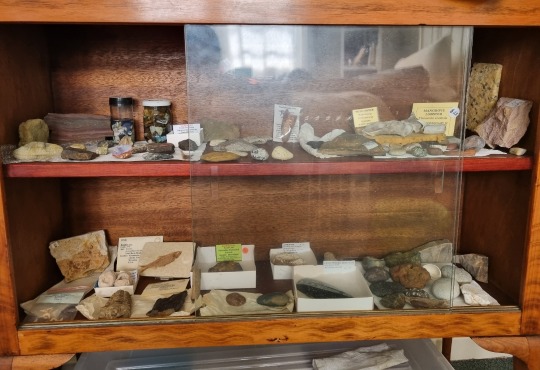

#rock collection#most of these are either from the beach or rock shows#excuse the junk on my cabinet#and reflections...#It was bright today and I've been wanting to upload my rocks for a while but it didn't really come out good oh well#geology#rocks#fossils#mud lobster#lobster#paleontology#Knightia#Knightia alta#Trilobite#crinoid stem#ammonite#Orthocone#Fossil cocoon#cocoon#shark teeth#Spinosaur#Spinosaur tooth#Sea urchin#Tetragramma violare#eucalypt leaf#fossil leaf#sedimentary rock#metamorphic rock#tigre iron
54 notes
·
View notes
Text
Look at what I made my husband for Valentine’s Day 🥹


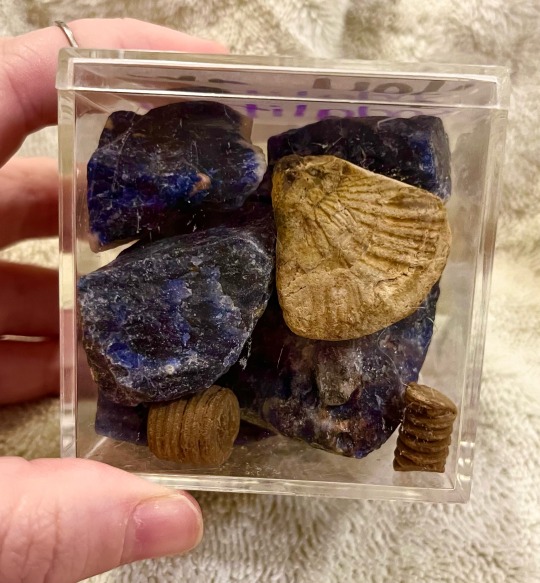
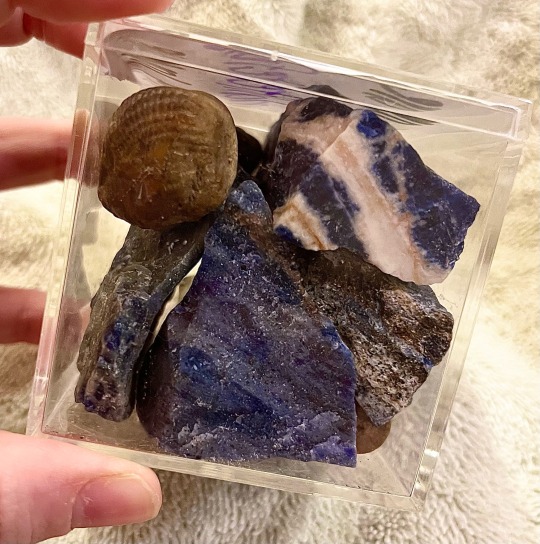
#he gets like….so many rocks as gifts#he wears a wishing stone I gave him around his neck#and always keeps a cool rock from me in his pocket#he never even cared about rocks before we met#I love him so much#rocks#crystals#sodalite#quartz#crinoid#crinoids#crinoid stem#crinoid fossil#fossils#fossil#paleoblr#palaeontology#palaeoblr#paleontography#paleo#cool rocks#gift#handmade gift#shell fossil#shell#river find#rock collection#fossil collection
73 notes
·
View notes
Text

I found what I believe to be several crinoid stems from the top down in what looked to be a sedimentary rock. It's the first fossil that I've found in the wild, I'm very excited.
6 notes
·
View notes
Text

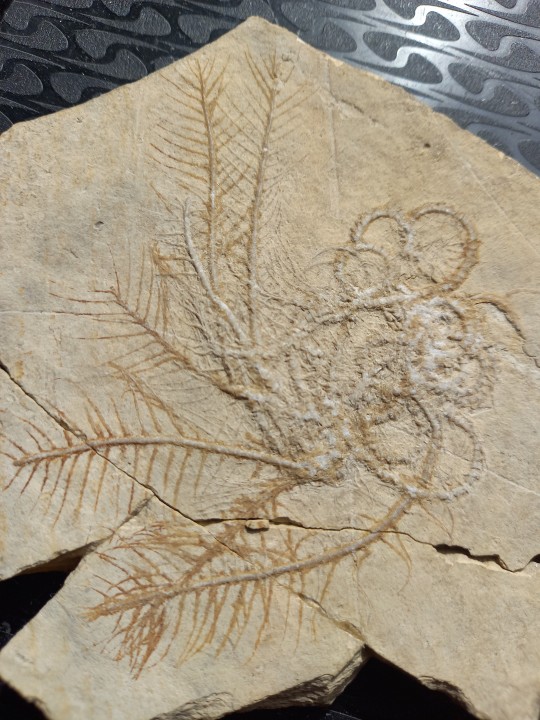

Fossil Time!
This year I'm branching out into many different streams of Geoscience - sustainability, resources, Palaeontology and of course, volcanology. I'm hoping this will let me explore all these exciting fields and maybe I'll do a masters in something I may have never considered!
The fossils are from the Jurassic period - click to see them in better quality. I think my favourite is the Crinoid which has the feathery frond-like appearance. The stacked circles (like coins) seen in the last photo are crinoid stems.
#geology#geoblr#palaeoblr#fossil#crinoid#studyblr#science#women in stem#earth science#rocks are cool
36 notes
·
View notes
Text
Tell me about the holiest place you've ever been (whatever that means to you).
Mine is the Wichahpi Commemorative Stone Wall, in my hometown, built by hand by Tom Hendrix to commemorate the journey of his great-great-grandmother Te-Lah-Nay, a Yuchi woman who walked all the way back to Alabama from Oklahoma after being forcibly removed via the Trail of Tears.
youtube
#I was lucky enough to visit the wall a couple of times while Tom Hendrix was alive and to hear the story from him#he also gave me a crinoid stem fossil from the wall <3#if I ever go back to America I will be taking a stone from Scotland to leave at the wall#sacred places#alabama#fynn posts#Youtube
1 note
·
View note
Text

Fossilas: crinoid stems and stars including a 6 pointed pentacrites and a pyritised ammonte
25K notes
·
View notes
Text

Crinoid stems and stars including a 6 pointed pentacrites and a pyritised ammonte
2K notes
·
View notes
Text
Thinking about her (crinoids)
#there should be more pictures of stemmed crinoids#feather stars are cool but sea lillies deserve love too!!!!#crinoids#i hope i haven't made this post already
0 notes
Text

It’s Trilobite Tuesday! Every trilobite fossil tells a story about life in the Paleozoic seas, some 500 million years ago. This specimen—a rare 1.5-in- (3.8-cm-) long Achatella carleyi from Kentucky's Ordovician Fairview Formation—is preserved amid a field of crinoid stems!
#science#amnh#museum#fossil#nature#natural history#paleontology#trilobite#trilobite tuesday#did you know#fact of the day#ancient animals#paleozoic#kentucky#ordovician
377 notes
·
View notes
Text
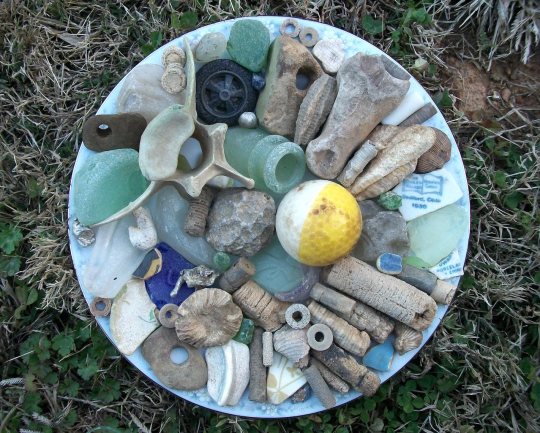


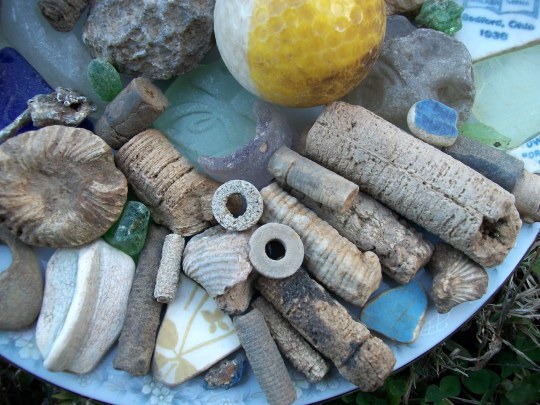
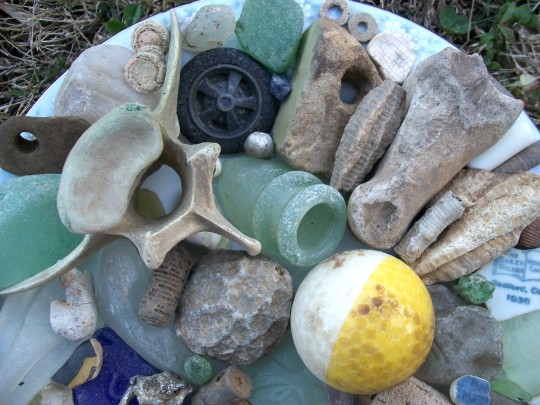
Time for a new plate of creek treasures!
We've had a few little rains here recently, not enough to really make the creek flood much but still just enough to uncover a few new finds. Here we have a cow toe bone, a deer vertebrae, toy wheel, two-tone golf ball, a sweet little partial porcelain plate from an old doll's dish set (all that's left is the stem but it had a little flower painted in the middle—so cute!), hag stones, colorful bits of tumbled vintage glass, neck off an old soda bottle, some really nice chunky crinoids and other cool fossils, and...

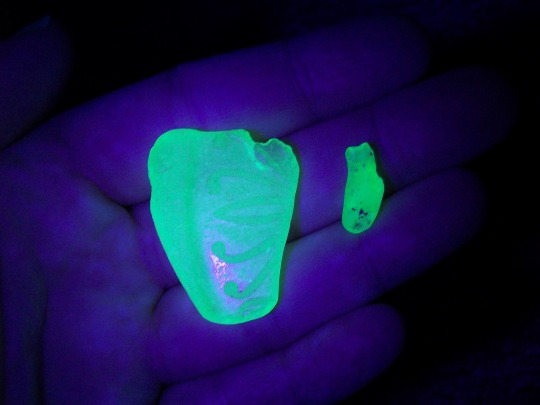

...a couple pieces of uranium glass! Always love finding those! I think that is the first nugget of bonfire uranium glass I've found.
#mudlarking#creeklarking#trinkets#uranium glass#fossils#tumbled glass#hag stones#crinoids#creek treasures
153 notes
·
View notes
Text
It's too bad Halloween was yesterday because I would have done a Wet Beast Wednesday on something creepy, like the tongue-biting isopod. It's not though, so so I'm dipping my toes into echinoderm science and talking about crinoids. While crinoids are the least famous echinoderms, being overshadowed by their relatives the starfish, sea urchins, and sea cucumbers, they are extremely well-represented in the fossil record. We know of far more extinct crinoid species than living ones.
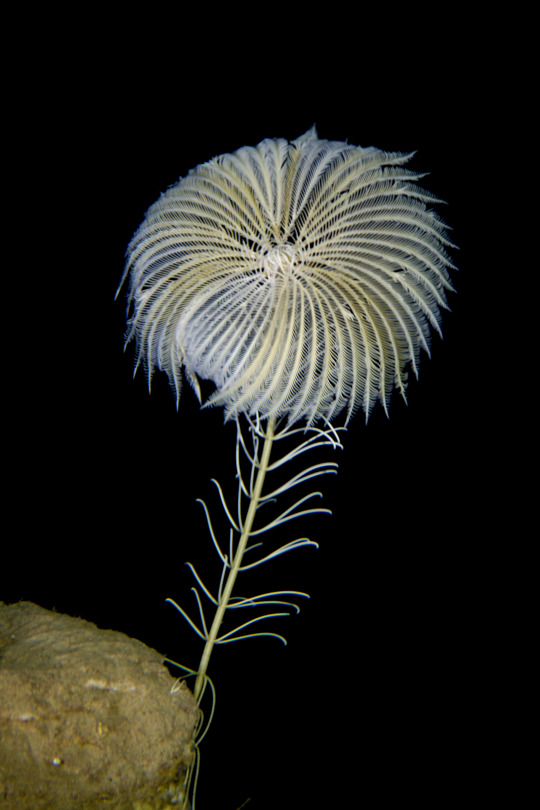
(imag id: a crinoid attached to a rock. It is a long, slender stalk with multiple threadlike protrusions emerging from it. At the top is a crown that looks like a flower composed of feathery appendages. It is while all over)
As with all echinoderms, crinoids are bilaterally symmetrical as larvae for become radially symmetrical while adults. It is hypothesized that the ancestor of all echinoderms was a bilaterally symmetrical animal that evolved to become radially symmetrical as adults. This places echinoderms in the same clade as all other bilaterally symmetrical animals, including mollusks, arthropods, most worms, and all vertebrates. You are more closely related to a starfish than a starfish is to a jellyfish. Crinoids are one of those animals like anemones that look more like flowers than animals, which is why they're also called sea lilies. A typical juvenile crinoid consists of a stalk with a holdfast on one end and crown on the other. The stalk is segmented and made of porous calcified material called ossicles, which are attached to each other by discs. This is the part of a crinoid that fossilizes most easily and a great many crinoid fossils are only known from their stems. The holdfast is a root-like structure that attaches the crinoid to a substrate. Crinoids that attach to a hard surface have a branching holdfast to grip on while crinoids that attach to sediment have a thick, stalk-like holdfast that penetrates into the substrate like a tree's taproot. The crown is the part that looks like a flower and consists of two parts: the theca/calyx/arboral cup and the rays. The theca is shaped like a cup and has a mouth in the center. The mouth connects to a simple u-shaped gut that leads to an anus near the mouth. The rays are analogous to the arms of a starfish. All echinoderms have 5 symmetrical body segments and crinoids have five rays, though they usually branch after emerging from the theca, resulting in up to a few hundred total rays. The rays are segmented like the stalk and can curl up. Crinoids will curl up their arms and pull them in to protect them. The rays are used in feeding. Crinoids are passive suspension feeders that wait for plankton and organic particles to be carried into the rays by the current. Each ray is covered by flexible appendages called pinnules that give the rays a feathery appearance. Each pinnule is covered by tube feet that are coated in sticky mucus. When a food particle hits the tube feet, they grab on and transfer it to the center of the ray, which contains a canal called the ambulacral groove. The groove is filled with cilia that carry the food particle down to the mouth. All crinoids take this form during their juvenile phase, but only a few modern species retain it for their entire lives. Most modern species will shift into an adult form where the stalk falls off and the theca becomes free-swimming. These are often called feather stars. Both stalked crinoids and feather stars can use their rays to pull themselves along the substrate, but feather stars can also wave their rays around to swim. Swimming allows feather stars to more readily avoid danger and become more active in their attempts to catch food.

(image: a diagram of crinoid anatomy. source)
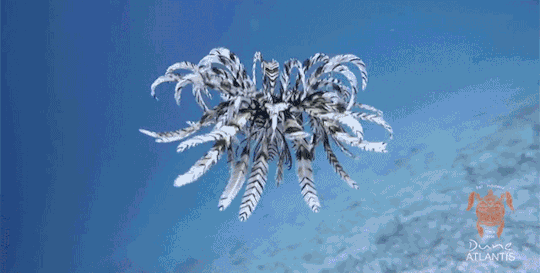
(gif id: a feather star swimming. It looks like a bunch of black-and-white striped feathers attached to a central disc. The arms are undulating, propelling the feather star through the water)
Crinoids are dioecious, meaning individuals are either male or female. In most species, the gonads are in the pinnules closest to the theca. The gonads actually swell up and cause the pinnules to burst and release the gametes. Different species have different strategies. In some, both sperm and eggs will be released into the water column. In others, only the males broadcast sperm which the females use to fertilize their eggs. The eggs are withheld by the mother, either by gluing them to her arms or incubated in sacs on the arms. The larvae, called vitellaria, are free-swimming and bilaterally symmetrical. They will swim for a few days before dropping to the substrate and attaching. They then metamorphose into juveniles.

(image: a diagram showing a crinoid progressing through multiple developmental stages from fertilized egg to larva. source)
The fossil history of crinoids dates back to the Ordovician period (485-444 million years ago), the period between the Cambrian and Silurian. While echinoderms and even stalked echinoderms existed during the Cambrian, the oldest definitive crinoid fossils are Ordovician and it's unclear which extinct group that crinoids evolved from. For over two hundred million years, crinoids were extremely diverse and were dominant sessile filter feeders, beating out anemones and corals. The mass extinction at the end of the Permian dealt a major blow to crinoids that they never recovered from, causing them to lose their dominance and become much less morphologically diverse. The Permian mass extinction is a fascinating period of history as it was the single greatest mass extinction in the history of Earth. The early Triassic saw a mass adaptation to more flexible and motile body plans in response to increased predation. It's not clear when feather stars entered the picture, though they may have come about due to predation in the Triassic. Some extinct crinoids had different survival strategies than modern ones. The genus Pentacrinites attached themselves to driftwood and floated through the open ocean. They would have been like floating islands of diversity moving through the oceans with lots of other animals following for food and shelter. A fact that gets passed around a lot is that the largest fossil crinoid ever found (Taxocrinus saratogensis) was 40 meters (130 ft) long. That isn't true and seems to stem from a misprint. It was actually 40 ft (12.2 m) long, which is still fucking enormous. Crinoids today don't get anywhere near as large as extinct ones could. Fossil crinoids measuring many meters in stem length are well documented while ones alive today never even reach a meter long. Crinoid fossils are extremely common and can be used to provide relative dates to nearby fossils. In some places, enough crinoid parts fossilized near each other that they became clustered together in sedimentary rocks called encrinites.

(image id: a fossil imprint of many crinoids attached to a piece of driftwood. The imprints ore in a flat, tan rock. The driftwood imprint looks like a long, dark blob. The crinoids have long, curved, and overlapping stems and fan-like crowns at the top. Fossil found at the Houston Museum of Natural Science)
#wet beast wednesday#crinoid#sea lily#feather star#echinoderm#paleontology#marine biology#biology#zoology#ecology#invertebrate
161 notes
·
View notes
Text

Little babies
#fossils#fossil#shell fossil#crinoids#crinoid#crinoid stem#river rocks#river find#paleoblr#paleontology#rock collection
59 notes
·
View notes
Text
Here are some fun crinoids I saw of varying sizes.


2 notes
·
View notes
Text
Strange Symmetries #03: Eerie Early Echinoderms
Represented today by starfish, brittle stars, sea urchins, sea cucumbers, and crinoids, the echinoderms have a characteristic five-way radial symmetry that makes them barely even recognizable as bilaterians. Their true ancestry is only revealed by their genetics and their larvae, which still retain bilateral symmetry – and the way they metamorphose into adults is bizarre, essentially growing a whole new radial body from within the left side of their larval body.
(Sea cucumbers and sand dollars are superficially bilateral as adults, but evolved this secondarily on top of their existing radial symmetry. And some adult echinoderms like starfish also seem to retain a little bit of "behavioral bilaterism", generally preferring to move with a specific arm always acting as their "front" end.)
The first known echinoderms appeared in the fossil record during the early Cambrian, about 525 million years ago, but the common ancestor of the whole group probably actually originated a few tens of millions of years earlier in the mid-to-late Ediacaran. Early echinoderms seem to have started off as flattened animals that sat on the seafloor filter-feeding, and with this largely immobile way of life their bodies started to shift into asymmetry, no longer constrained by the locomotory advantages of being bilaterally symmetric.
In fact, for these early sedentary filter-feeders being radial was actually much more advantageous, able to distribute sense organs all around their bodies and grab food from any direction without having to reposition themselves, converging on the lifestyle of non-bilaterian cnidarian polyps. The evolutionary transition from bilateral to asymmetrical to pentaradial seems to have happened incredibly quickly during the Cambrian Explosion, and all modern echinoderms probably evolved from a group called the edrioasteroids, maintaining their new base body plan even when they later began taking up more mobile lifestyles again.
But during the process of all that some very alien-looking lineages split off at various stages of anatomical weirdness.
Stylophorans had asymmetrical bodies with a single feeding arm at the front, and varied from irregular boot-like shapes to almost bilateral heart shapes depending on their specific ecologies. The highly asymmetrical forms were probably spreading their weight out over soft soupy mud in quiet waters, while the more bilateral forms may have been more streamlined to deal with stronger water currents.
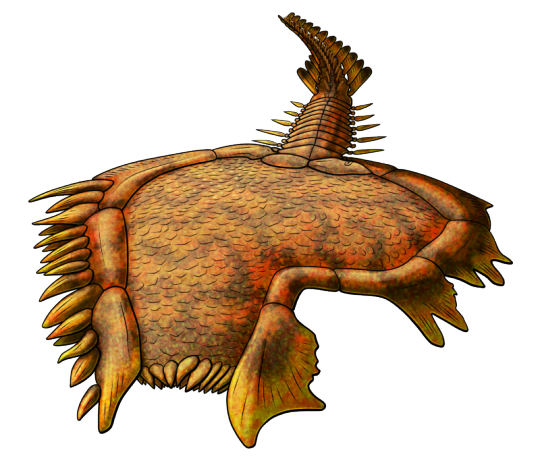
Sokkaejaecystis serrata was a stylophoran that lived during the late Cambrian, about 501-488 million years ago, in what is now South Korea. It was tiny, only about 1cm long (~0.4"), and its boot-shaped body was surrounded by spines and flanges that spread out its surface area and probably also made it much more awkward for small predators to attempt to eat.
———
Meanwhile the solutes started off as immobile animals living attached to the seafloor via a stalk-like appendage. But fairly early in their evolution they switched to a more active mode of life, modifying their stems into tail-like "steles" that were used to push themselves along.
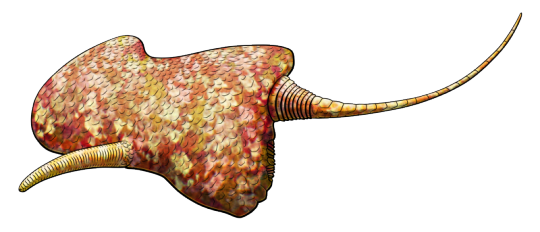
Maennilia estonica lived in what is now Estonia during the late Ordovician, about 450 million years ago. It was quite large for a solute at about 12cm long (~4.7"), with a sort of vaguely-trapezoidal body, a short feeding arm, and a long thin stele.
Both of these strange early echinoderm lineages were surprisingly successful, surviving for a good chunk of the Paleozoic Era alongside their more familiar radial relatives. The solutes lasted until the early Devonian about 400 million years ago, and the stylophorans continued all the way into the late Carboniferous about 310 million years ago.
———
NixIllustration.com | Tumblr | Twitter | Patreon
#science illustration#strange symmetries#paleontology#paleoart#palaeoblr#sokkaejaecystis#stylophora#maennilia#soluta#echinoderm#ambulacraria#deuterostome#bilateria#art#eldritch echinoderms#go home evolution you're drunk
508 notes
·
View notes
Note
Thoughts on the Lileep line? They do feel pretty distinct among fossil Pokemon.
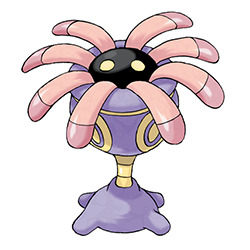
I always really liked Lileep. It's based off a crinoid (sea lily), which ironically aren't actually extinct. They do appear in fossils pretty often though, so that's probably the justification behind them being fossil 'mon.

The actual design is really cool. I'm always a sucker for dot eyes on a dark background, and the face combined with the surrounding tentacles really creates a neat look. The body also has a distinct look, with a "cup" on the top half, a thin yellow stem, and four suction-cup legs on the lower half. The yellow markings give it a bit of additional flair and really add to the prehistoric look. Really, I have absolutely no complaints here. Just a very unique monster design all around.

Cradily is also pretty neat—in particular, I find the way the ring markings become a giant pair of false eyespots to be really cool both visually and conceptually. The eyes being inside of the "mouth" also helps it be unique from Lileep without losing any of its main attributes.
I have to admit though, while it's still a very solid design, I don't like it quite as much as Lileep. The thicker neck looks a bit too animal-like; I feel like having it be sectioned off and all yellow would've gotten the plant-ish traits across better.
I also feel like the way the legs are splayed out makes it look like it fell down and now can't get back up. If anything, it having legs it could actually stand up on could've been an interesting progression, or it also might've looked good with no legs at all. Also, I kind of miss the purple (though granted, it might be green to convey its grass-typing). It's still a good evo all around, but those few things make me prefer Lileep just a bit more.

Anyway, overall, this is a very solid line. I love how unique they both feel, especially relative to the amount of dinosaur 'mons we normally get for fossils, and the visuals are very memorable. I definitely wouldn't mind these guys getting some kind of evo in the future—though what else could be done with an already pretty great line is hard to say.
81 notes
·
View notes
Text
Yo I am about to have SO many lileep for my team


Joke aside, was just pretty darn excited about this find. I know they’re fairly common, but, someof the biggest crinoid stem fossils I’ve seen in person and this rock was chuck full of them. Think I’ll hold onto this.
24 notes
·
View notes